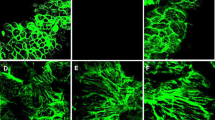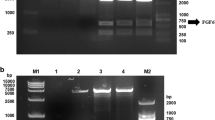Abstract
Fibroblast growth factor-16 (FGF-16) has been reported as the sixteenth member of the heparin sulphate proteoglycan binding growth factor family, which includes acidic and basic FGFs (FGF-1 and FGF-2), based on sequence similarity. The sequences of human (h) and rat (r) FGF-16 complimentary DNA (cDNA) sequences are known. Rat FGF-16 is expressed in brown adipose tissue during embryonic development but also shows some specificity for the postnatal heart. In spite of the importance of other FGF family members in cardiac physiology, there is scant information about FGF-16 function. As a first step towards exploiting mouse genetics in this regard, we have used reverse transcriptase-polymerase chain reaction and primers based on the rFGF-16 sequence to clone the adult mouse (m) FGF-16 cDNA. An mFGF-16 cDNA of 624 base pairs was generated. Based on sequence analysis, mFGF-16 and hFGF-16 share at least 95.2 and 99% nucleotide and amino acid similarity, respectively. In terms of other family members, FGF-16 is most closely related to FGF-9. When used as a radiolabeled probe, the mFGF-16 cDNA detected a single 1.8 kilobase transcript in adult mouse heart RNA. The mFGF-16 cDNA was also used to generate an amino-terminal poly-histidine tagged FGF-16 protein in bacteria. Using sodium dodecyl sulphate-polyacrylamide gel electrophoresis and taking into account the poly-histidine tag, an FGF-16 protein of 26.3 kDa was detected. The generation of cardiac mFGF-16 cDNA and a purified FGF-16 protein preparation are seen as important tools in the further characterization of FGF-16 expression and function in the mammalian heart.
Similar content being viewed by others
References
Yamashita T, Yoshioka M, Itoh N: Identification of a novel fibroblast growth factor, FGF-23, preferentially expressed in the ventrolateral thalamic nucleus of the brain. Biochem Biophys Res Commun 277: 494-498, 2000
Faham S, Hileman RE, Fromm JR, Linhardt RJ, Rees DC: Heparin structure and interactions with basic fibroblast growth factor. Science 271: 1116-1120, 1996
Szebenyi G, Fallon JF: Fibroblast growth factors as multifunctional signaling factors. Int Rev Cytol 185: 45-106, 1999
Sugi Y, Lough J: Activin-A and FGF-2 mimic the inductive effects of anterior endoderm on terminal cardiac myogenesis in vitro. Dev Biol 168: 567-574, 1995
Barron M, Gao M, Lough J: Requirement for BMP and FGF signaling during cardiogenic induction in non-precardiac mesoderm is specific, transient, and cooperative. Dev Dyn 218: 383-393, 2000
Zhou M, Sutliff RL, Paul RJ, Lorenz JN, Hoying JB, Haudenschild CC, Yin M, Coffin JD, Kong L, Kranias EG, Luo W, Boivin GP, Duffy JJ, Pawlowski SA, Doetschman T: Fibroblast growth factor 2 control of vascular tone. Nat Med 4: 201-207, 1998
Ortega S, Ittmann M, Tsang SH, Ehrlich M, Basilico C: Neuronal defects and delayed wound healing in mice lacking fibroblast growth factor 2. Proc Natl Acad Sci USA 12: 5672-5677, 1998
Dono R, Texido G, Dussel R, Ehmke H, Zeller R: Impaired cerebral cortex development and blood pressure regulation in FGF-2-deficient mice. EMBO J 17: 4213-4225, 1998
Leconte I, Fox JC, Baldwin HS, Buck CA, Swain JL: Adenoviral-mediated expression of antisense RNA to fibroblast growth factors disrupts murine vascular development. Dev Dyn 213: 421-430, 1998
Pellieux C, Foletti A, Peduto G, Aubert J, Nussberger J, Beerman F, Brunner H, Pedrazzini T: Dilated cardiomyopathy and impaired cardiac hypertrophic response to angiotensin II and mice lacking FGF-2. J Clin Invest 108: 1843-1851, 2001
Fernandez B, Buehler A, Wolfram S, Kostin S, Espanion G, Franz WM, Niemann H, Doevendans PA, Schaper W, Zimmermann R: Transgenic myocardial overexpression of fibroblast growth factor-1 increases coronary artery density and branching. Circ Res 87: 207-213, 2000
Padua RR, Sethi R, Dhalla NS, Kardami E: Basic fibroblast growth factor is cardioprotective in ischemia-reperfusion injury: Mol Cell Biochem 143: 129-135, 1995
Cuevas P, Carceller F, Lozano RM, Crespo A, Zazo M, Gimenez-Gallego G: Protection of rat myocardium by mitogenic and non-mitogenic fibroblast growth factor during post-ischemic reperfusion. Growth Factors 15: 29-40, 1997
Padua RR, Merle PL, Doble BW, Yu CH, Zahradka P, Pierce GN, Panagia V, Kardami E: FGF-2-induced negative inotropism and cardioprotection are inhibited by chelerythrine: Involvement of sarcolemmal calcium-independent protein kinase C. J Mol Cell Cardiol 12: 2695-2709, 1998
Jiang Z, Padua RR, Ju H, Doble BW, Jin Y, Hao J, Cattini PA, Dixon IM, Kardami E: Acute protection of the ischemic heart by FGF-2; involvement of FGF-2 receptors and protein kinase C. Am J Physiol Heart Circ Physiol 282: H1071-H1080, 2002
Sheikh F, Sontag DP, Fandrich RR, Kardami E, Cattini PA: Overex-pression of FGF-2 increases cardiac myocyte viability after injury in isolated mouse hearts. Am J Physiol Heart Circ Physiol 280: H1039-H1050, 2001
Yanagisawa-Miwa A, Uchida Y, Nakamura F, Tomaru T, Kido H, Kamijo T, Sugimoto T, Kaji K, Utsuyama M, Kurashima C, Ito H: Salvage of infarcted myocardium by angiogenic action of basic fibroblast growth factor. Science 257: 1401-1403, 1992
Unger EF, Banai S, Shou M, Lazarous DF, Jaklitsch MT, Scheinowitz M, Correa R, Klingbeil C, Epstein SE: Basic fibroblast growth factor enhances myocardial collateral flow in a canine model. Am J Physiol 266: H1588-H1595, 1994
Harada K, Grossman W, Friedman M, Edelman ER, Prasad PV, Keighley CS, Manning WJ, Sellke FW, Simons M: Basic fibroblast growth factor improves myocardial function in chronically ischemic porcine hearts. J Clin Invest 94: 623-630, 1994
Laham RJ, Hung D, Simons M: Therapeutic myocardial angiogenesis using percutaneous intrapericardial drug delivery. Clin Cardiol 22(suppl 1): I6-I9, 1999
Horrigan MC, Malycky JL, Ellis SG, Topol EJ, Nicolini FA: Reduction in myocardial infarct size by basic fibroblast growth factor following coronary occlusion in a canine model. Int J Cardiol 68(suppl 1): S85-S91, 1999
Sellke FW, Laham RJ, Edelman ER, Pearlman JD, Simons M: Therapeutic angiogenesis with basic fibroblast growth factor: Technique and early results. Ann Thorac Surg 65: 1540-1548, 1998
Udelson JE, Dilsizian V, Laham RJ, Chronos N, Vansant J, Blais M, Galt JR, Pike M, Yoshizawa C, Simons M: Therapeutic angiogenesis with recombinant fibroblast growth factor-2 improves stress and rest myocardial perfusion abnormalities in patients with severe symptomatic chronic coronary artery disease. Circulation 102: 1605-1610, 2000
Miyake A, Konishi M, Martin FH, Hernday NA, Ozaki K, Yamamoto S, Mikami T, Arakawa T, Itoh N: Structure and expression of a novel member, FGF-16, of the fibroblast growth factor family. Biochem Biophys Res Commun. 243: 148-152, 1998
Kok LDS, Tsui SKW, Waye M, Liew CC, Lee CY, Fung KP: Cloning and characterization of a cDNA encoding a novel fibroblast growth factor preferentially expressed in human heart. Biochem Biophys Res Commun 255: 717-721, 1999
Hartung H, Feldman B, Lovec H, Coulier F, Birnbaum D, Goldfarb M: Murine FGF-12 and FGF-13: Expression in embryonic nervous system, connective tissue and heart. Mech Dev 64: 31-39, 1997
Konishi M, Mikami T, Yamasaki M, Miyake A, Itoh N: Fibroblast growth factor-16 is a growth factor for embryonic brown adipocytes. J Biol Chem 275: 12119-12122, 2000
Chomczynski P, Sacchi N: Single-step method of RNA isolation by acid guanidinium thiocyanate-phenol-chloroform extraction. Anal Biochem 162: 156-159, 1987
Danilenko DM, Montestruque S, Philo JS, Li T, Hill D, Speakman J, Bahru M, Zhang M, Konishi M, Itoh N, Chirica M, Delaney J, Hernday N, Martin F, Hara S, Talvenheimo J, Narhi LO, Arakawa T: Recombinant rat fibroblast growth factor-16: Structure and biological activity. Arch Biochem Biophys 361: 34-46, 1999
Fu X, Shen Z, Chen Y, Xie J, Guo Z, Zhang M, Sheng Z: Randomised placebo-controlled trial of use of topical recombinant bovine basic fibroblast growth factor for second-degree burns. Lancet 352: 1661-1664, 1998
Payne WG, Ochs DE, Meltzer DD, Hill DP, Mannari RJ, Robson LE, Robson MC: Long-term outcome study of growth factor-treated pressure ulcers. Am J Surg 181: 81-86, 2001
Freedman SB, Isner JM: Therapeutic angiogenesis for ischemic cardiovascular disease. J Mol Cell Cardiol 33: 379-93, 2001
Author information
Authors and Affiliations
Rights and permissions
About this article
Cite this article
Sontag, D.P., Cattini, P.A. Cloning and bacterial expression of postnatal mouse heart FGF-16. Mol Cell Biochem 242, 65–70 (2003). https://doi.org/10.1023/A:1021133611130
Issue Date:
DOI: https://doi.org/10.1023/A:1021133611130




